
1. Square Layout
Methods for laying out the room are the same for all kinds of resilient tile. However, there are two major types of patterns: designs laid on the square and designs laid on the diagonal. For either type of pattern, it is first necessary to center and square off the room. The basis for all resilient tile installations is careful layout.
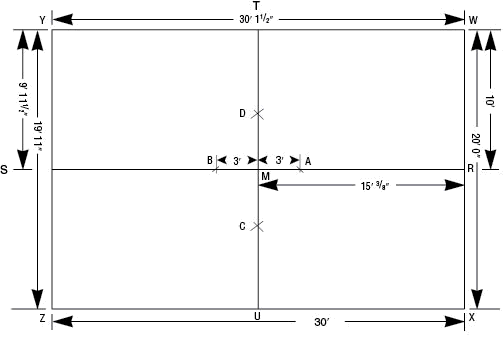
- If the room is rectangular with practically parallel walls on all sides, find the center. For instance, in Fig. 46, wall WX is 20′, wall YZ is 19′ 11″, wall XZ is 30′ and wall WY is 30′ 1-1/2″.
- Carefully measure across wall WX and wall YZ to find the midpoints at R and S. In this case, WR is 10′ and YS is 9′ 11-1/2″. Strike a chalk line on the floor between R and S.
- Next, find M, which is the midpoint of line RS. At M, strike a chalk line TU at a right angle to RS. In this case, midpoint M is 15′ 3/8″ from both R and S. To make the line TU exactly a right angle to line RS, proceed as follows:
- With M as a center point, measure and convenient distance on line RS. Mark the substrate at these two points A & B. These lines will act as reference points to make arcs C & D
- With A as a center point, construct an arc any distance greater than the distance between A & M. Construct an arc on both sides of T and U.
- With B as a center point and using the same radius as used with A, construct another arc on both sides of T and U.
- Arcs from A & B will cross each other at points C & D. Through points C, D & M, strike a line TU which is exactly at a right angle to RS.If carefully done, this method is more accurate than using a square to strike the right angle, especially in larger rooms.
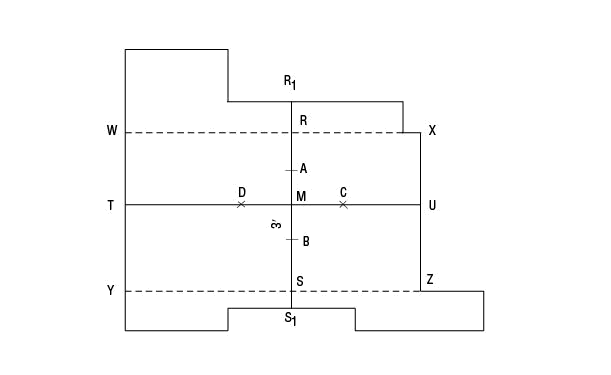
In rooms with bays or alcoves in the walls, the method is the same except that centers R and S are found at the points shown in Fig. 47. Then, point M is found midway between R1 and S1. Before installing, lay the tile dry or measure to find out the size of the pieces at the wall line. For example, consider the layout of a design using 12″ x 12″ tile laid in a room 15′ 4″ x 20′ 8″ (Fig. 48).
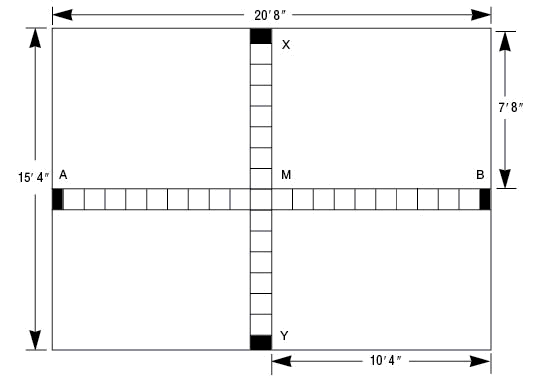
After striking center lines AB and XY, lay the tile dry from point M to wall B and from point M to wall X. The distance between M and X is 7′ 8″ and between M and B is 10′ 4″. When the 12″ x 12″ tile are laid from the center to the wall, the last row of tile at walls X and Y will have to be cut to 12″ x 8″. At walls A and B, the last row of the tile must be cut to 12″ x 4″. The tile at opposite walls should be of equal size and at least half a tile. Since walls A and B are not at least half a tile, an adjustment must be made (Fig. 48).
The adjustment is to move line XY. Another chalk line is struck parallel with XY but 6″ (one half the width of a 12″ x 12″ tile) to either side of XY. The distance from this line to walls A and B becomes 10′ 10″ and 9′ 10″, respectively. The fit pieces of tile along the last row of walls A and B will now be 12″ x 10″. This new line is X1Y1. Eliminate the old center line XY (Fig. 49).

The row starting at the new center M and running along line MX will include seven full 12″ x 12″ tile plus one tile that must be cut to 12″ x 8″. Line MB will include nine full tile plus one tile that must be cut to 12″ x 10″. The 12″ x 10″ tile along walls A and B balance with the 12″ x 8″ tile along walls X and Y.
If the dimensions for walls X and Y also had allowed only small strips of tile to be used at the walls, the center line AB could have been adjusted in the same manner.
2. Diagonal Layout
- For diagonal layouts, square off the room and strike center lines as for square layouts. Then set up diagonal lines (Fig. 50).
- With point M as a center and using any convenient radius, mark points A, B, C and D on lines SR and TU.
- With B and C as centers, and using a radius greater than the distance between points C and M, mark intersecting arcs at E.
- With A and D as centers, mark intersecting arcs at F.
- Strike an extended chalk line YZ through EMF to the walls.
- With A and C as centers, mark intersecting arcs at G.
- With B and D as centers, mark intersecting arcs at H.
- Strike an extended chalk line WX through GMH to the walls.
- To find the number of tile across the room, lay a row of tile dry – point to point – along each center line (Fig. 51)
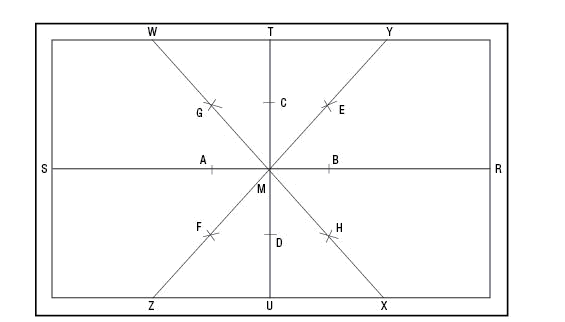
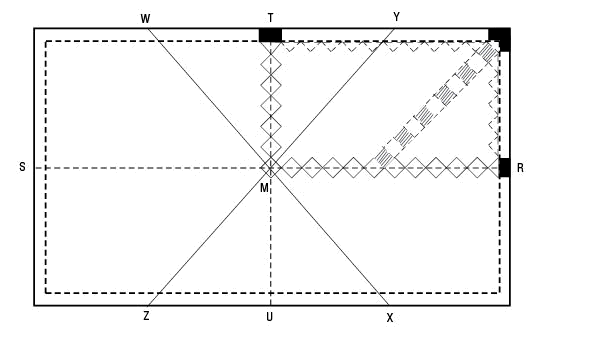
The point at which a diagonal design is started depends on the size of the room. When a diagonal design includes more than one color, a border is generally desirable. With two or more colors, it is necessary to start with one tile on center so that the design will come out with a half tile of the same color along walls T and R and a quarter tile in the corner. Adjust the size of the border to permit the use of full and half tile at the edges of the field. That will eliminate the need to cut odd-sized diagonal tile to fit around the sides of the room. For example, if white half tile are wanted on border, start with white tile on center. For black half tile on border, start with black tile on center. This would not apply to a one color floor.
When a design is properly laid on the diagonal, all half tile at the border or wall line should be of one color and quarter tile should be used in each corner (Fig. 52).
When using two or more colors of resilient tile in diagonal designs, the graining of the half tile at the border should run in the same direction as the graining of the corresponding color of full tile (Fig. 53). Two types of half tile are required. They are known as right half tile and left half tile. In right half tile, the grain runs up to the right from the longest side of the half tile. In left half tile, the grain runs up to the left from the longest side of the half tile. With the grain of the full tile running from top to bottom, right half tile are cut on a diagonal from the lower left corner to the upper right corner and left half tile are cut on a diagonal from upper left corner to lower right corner. The diagonal side becomes the edge that will be butted against the wall side. Depending on the size of the room, it may be necessary to start the design with the corners of four tile on midpoint M to obtain half tile of the same color along walls T and R and a quarter tile in the corner (Fig. 54). To change the color of the half tile in this case, reverse the colors of the four tile at the center.
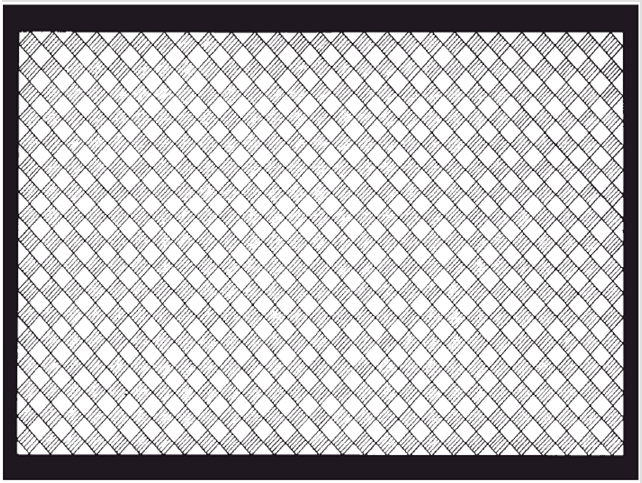
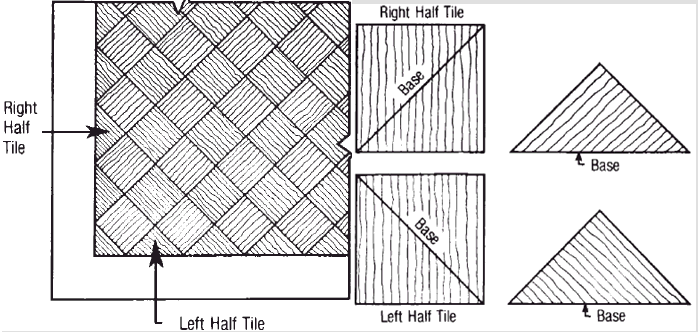
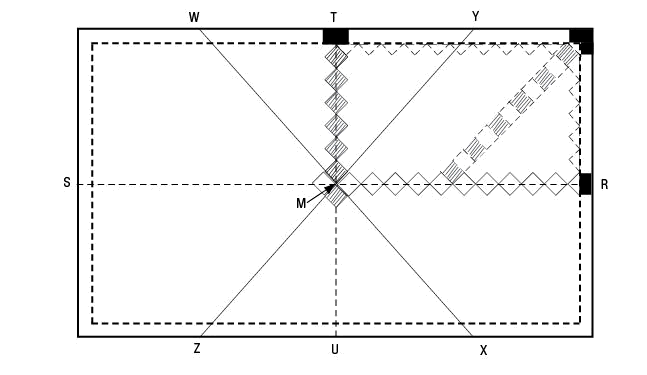
Fig. 55 is an example of a diagonal design laid out incorrectly. Although the border width is in proportion for the room, half tile along the border at wall R are black, and half tile along the border at wall T are white. This incorrect diagonal design can be easily corrected without changing the width of the border by beginning the job with four tile on the center line (Fig. 54).
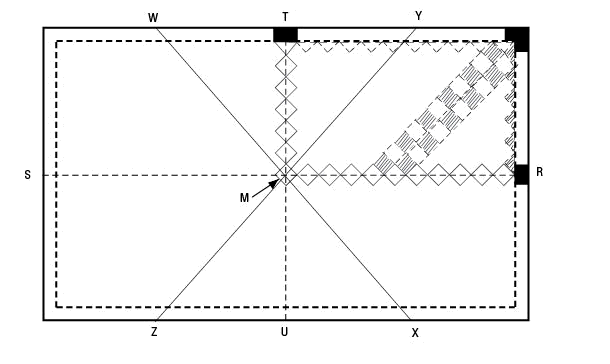
If dry fitting the tile shows the center tile should be placed squarely over midpoint M for proper border width (Fig. 51), it will be necessary to set up diagonals WX and YZ . Mark diagonal lines W1X1 and Y1Z1 half the width of a tile away from, and parallel to, the diagonal lines WX and YZ (Fig. 56).
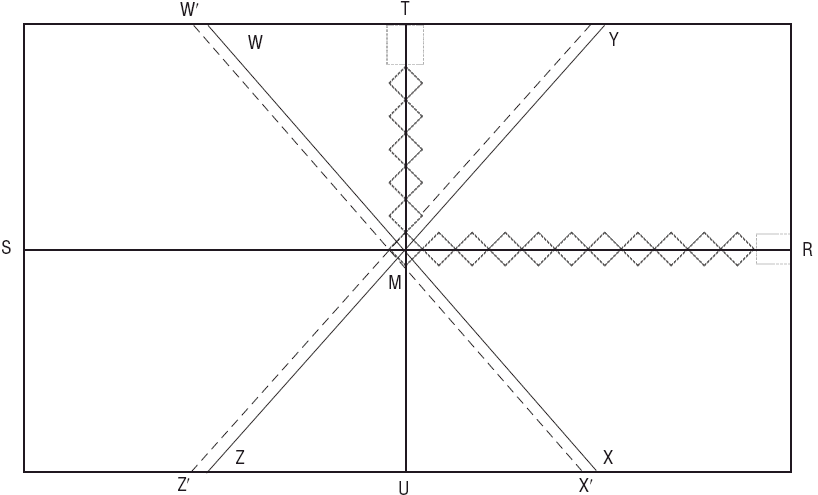
After locating diagonals, spread adhesive and install tile following the diagonal center lines (Fig. 57). Using the starting point established after dry fitting, fit the center tile into position at the junction of lines WX and YZ or W1X1 and Y1Z1. Lay diagonal designs with the first row fit along the diagonal center lines of the layout.
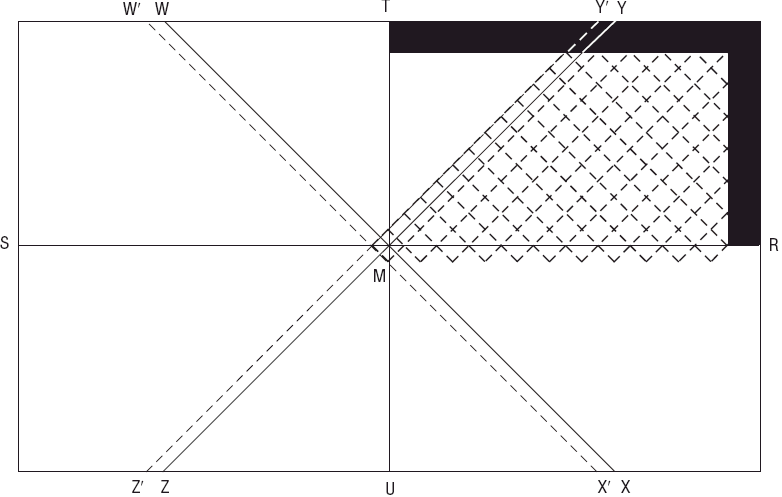
3. Spreading Adhesive
After properly preparing the subfloor and establishing the center lines and layouts, spread the proper adhesive with a notched trowel. Spread the adhesive over half the room. You can handle materials in the clear half of the room without getting into the adhesive and tracking it over the new floor.
Give the adhesive ample time to set up before the tile is installed. Humidity and temperature changes will affect the length of time for the adhesive to set up. To test for proper set, lightly press your finger over the adhesive surface at several locations. If adhesive feels dry to the touch, it is ready for tile installation. If the adhesive sticks to your finger, additional drying time is needed.
To avoid losing the center line when spreading adhesive, leave a small exposed spot where the lines cross and another spot where the line meets the wall. If the center line is very long, you may want to leave additional spots every few feet along the line. then using the exposed sections of the original line as a guide, strike a new chalk line on top of the adhesive after it is dry and spread adhesive over the exposed spots.
4. Installation
After the adhesive is set, place the first tile squarely into position at the point where the center lines cross. It is very important to lay the first few tile perfectly on the guidelines as they will affect the entire installation. For square or checkerboard designs, one quarter of the room should be laid in a step or fan shape, following the chalk lines struck on the floor. As an example, the tile are numbered as they should be laid (Fig. 58).
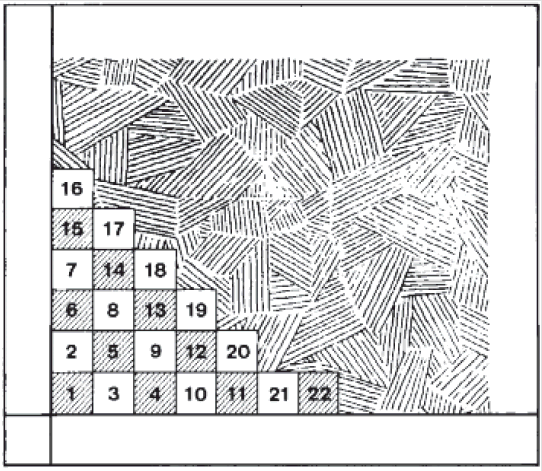
When repeating a design, adjust the center line so that the full design falls as close as possible to the wall line. It is often helpful to lay the tile designs on the floor dry to see how they are going to work out (Fig. 59).
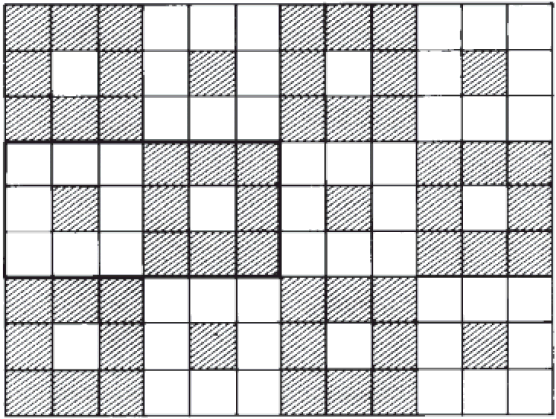
On larger installations of commercial tile, open several boxes of tile at one time and mix them as they are installed. This will help to blend the tile if there is a slight shade difference from one box to the next.
If the subfloor is not completely level, “run-off” may occur. This is evident when the corners of the tile are not meeting exactly. The best way to fix this problem is to leave a tile out to be installed later and continue to install the other tile around the opening. The tile left out must be larger than the opening. Heat this tile from the back and place the corners of the tile into the open space. Lay an unheated tile over the heated tile and apply pressure to compress the unheated tile into the opening.
5. Fitting
A. Square Layout
To fit resilient tile to straight walls, place a loose tile “A” over the last full tile in the row. In a “turnblock” design, turn the graining of adjacent tile at a 90 degree angle. In a checkerboard design, keep the graining running in the same direction. Over the loose tile, place a full tile “B” and butt it against the wall (Fig. 60). Score or mark along the edge of tile “B”, marking tile “A”. Cut along this line with a knife or tile cutter and install tile “A” against the wall.
If you will be using wall base or molding to cover the edges, you can score many tile with a knife and break them along the score line. This does not give a perfectly clean line, but it is adequate if molding or wall base is installed.

B. Diagonal Layout
To fit tile along a straight wall in a diagonal design, use a template made of sheet goods, hardboard or metal cut to the diagonal width of the tile being installed. For a diagonal 12″ x 12″ tile, the measurement is approximately 17″ (Fig. 61). Lay the tile to be fit over the last full tile. Use the template to mark where the tile is to be cut (Fig. 62).
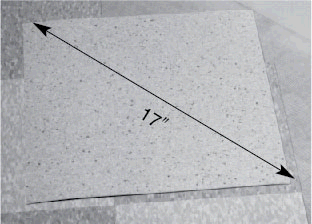
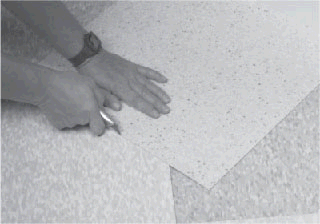
C. Irregular Walls or Door Trims
You can fit irregular walls or door trims by direct scribing. Rough the tile to about 3/4″ over the size needed. Place this piece of tile over the last full tile and against the object to be fit, with the excess overlapping the last full tile. Set your dividers to the same distance of the overlap (Fig. 63). This overlap must be consistent across the edge of the tile. Scribe the tile (Fig. 64). Heat the back of the tile, cut along scribe marks and place it in position.
When direct scribing tile for a diagonal layout, draw lines from corner to corner of the field tile to keep the tile being fit squarely aligned (Fig. 65).
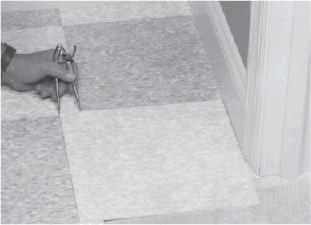
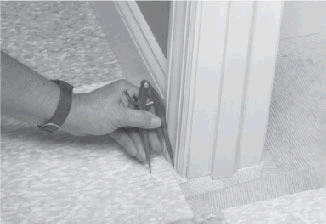
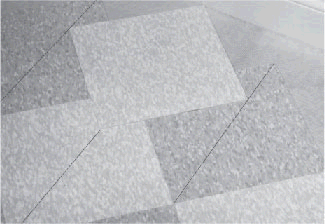
D. Pattern Scribing
Fitting very difficult areas is sometimes best accomplished by pattern scribing. Cut a piece of scribing felt the exact size of the tile. Place the felt in the area to be fit (Fig. 66). If adhesive is already spread, use two pieces of felt. The first piece will pick up some of the adhesive which could get on the face of the tile when the pattern is transferred. Scribe the felt pattern. Place the pattern over the tile (be sure graining is running in the proper direction) and transfer scribe marks (Fig. 67). Heat the back of the tile, cut along scribe marks and place it in position.
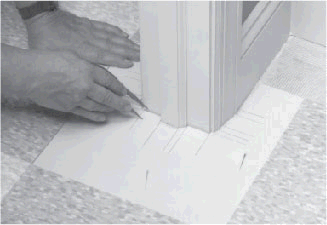
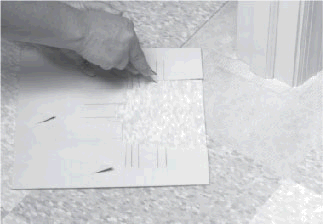
6. Finishing the Job
Most resilient commercial tile does not need to be rolled upon completion of the installation. However, residential tile and certain specialty tile must be rolled – refer to Tile Installation System for recommendations. Do not wash tile for at least 5 days after installation.
